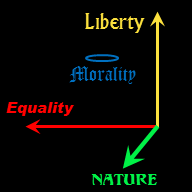“Paying Not to Plant”
Another way in which farm prices are artificially raised is that some farmers are paid not to plant. This reduces the supply of farm products, which puts more money in the hands of those still planting.
A similar program exists for those who save money: Social Security. Workers are encouraged to spend less by having the government provide for their retirement on a “pay as you go” basis. However, unlike the farm subsidy, workers pay a regressive tax for this benefit, giving them less money to save on their own behalf.
On the surface, Social Security appears to be progressive; many poor old people depend on it. However, many of these poor old people would have had a large nest egg had there been no Social Security. And less obvious, the process of having millions of laborers saving for retirement would have pushed down real interest rates and thus boosted labor rates – more tools chasing the same number of workers.
Some of the workers would have taken their retirement savings to start their own businesses during their careers instead of working for big corporations all their lives, and then sold their businesses upon retirement.
Upon death, many of these labor class retirees would have funds left over for their children, bringing them up to the next level of wealth. These children would have seed capital for starting their own business, continuing the family business, or living without a mortgage.
Of course, there is a downside to this alternative vision: some workers will invest poorly, or will lack the discipline to save at all. Such is the price of power: the need to take responsibility.
This is not to say that we need to let the unlucky or the irresponsible starve upon old age; it is that we should presume competence and responsibility for most and have some type of welfare program or charity for those that prove to the contrary. I will give some thoughts on how to do this in a later chapter.
A Different Retirement Path
With all my talk of “attacking” the investor class, I suspect I have worried a rather large class of people, people who may look rich on paper but in reality are not rich: the retired. A lower rate of return on investment means that one needs a greater retirement nest egg to get by.
If we move away from Keynesian economics back to the older idea of the virtue of thrift, people will need to save more in order to be able to retire comfortably. But worker incomes will be higher since less money is needed to finance the tools the workers use, so this will not be a problem for the next generation of retirees.
However, what about those already retired, or nearing retirement? Fortunately, the market automatically provides compensation for the changeover: when interest rates fall, the values of existing bonds and stocks rise. Suppose you pay $1000 for a bond that pays 10% interest. You have bought an instrument that pays $100/year. Now suppose that interest rates fall to 5%. Your $1000 bond now pays the same amount as a new $2000 bond. Your bond goes up to $2000 in price. The same holds for price/earnings ratios of stocks. Note that this is a one time jump. Unfortunately, many people will buy on momentum causing stock prices to go up even more, temporarily, followed by some type of crash as the market seeks the new equilibrium.
It would be nice if the average investor understood these things rather than blindly buying on momentum. I wonder if it would help if some lessons on basic finance theory were taught as part of high school…
One problem with private retirement savings is that many people don’t think hard about retirement until later in life. Another problem is that many people are not sophisticated investors. These problems run up against the standard model of retirement, where you are expected to contribute a small portion of your income over the course of life and expect market appreciation to do much of the work.
Consider a different model. Instead of saving for retirement when you are young, you put your excess wealth into learning jobs skills, starting a business and paying down debts. Later in life, the surplus goes into educating your children. Then, once the children become independent, you save like crazy. Is this reasonable? What about missed market appreciation?
Well, in a fully capitalized society, conservative investments will only provide 2-3% per year. If your job skills grow over time, your income will keep up with or outpace interest rates, so there is no advantage to saving earlier. Also, if you pay down your house quickly, you have a zero risk method of “investing.” The interest rate you earn is the reduction of mortgage interest not paid out. And if you pay for your children’s college as you go, there are no debts there.
So you hit your early fifties, and there are no children in your paid off house. You are in your peak earning years and have a major reduction in expenses. You could even sell your house and live in a smaller house. What fraction of your wealth could you save?
Such is not a plan for everyone, but I think it fits the psychology of many people better than the “start putting money into Wall St. when you are 20” life plan. And remember, in a low interest rate world, labor incomes will be higher, more money available for saving.


